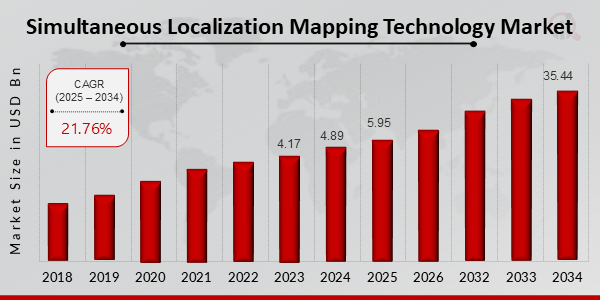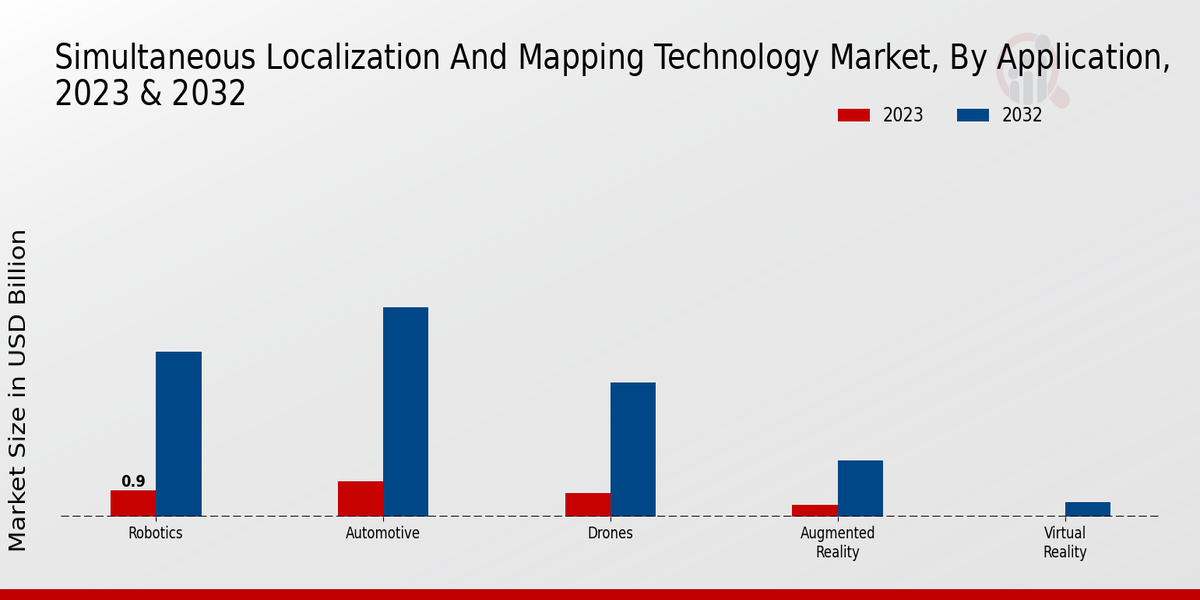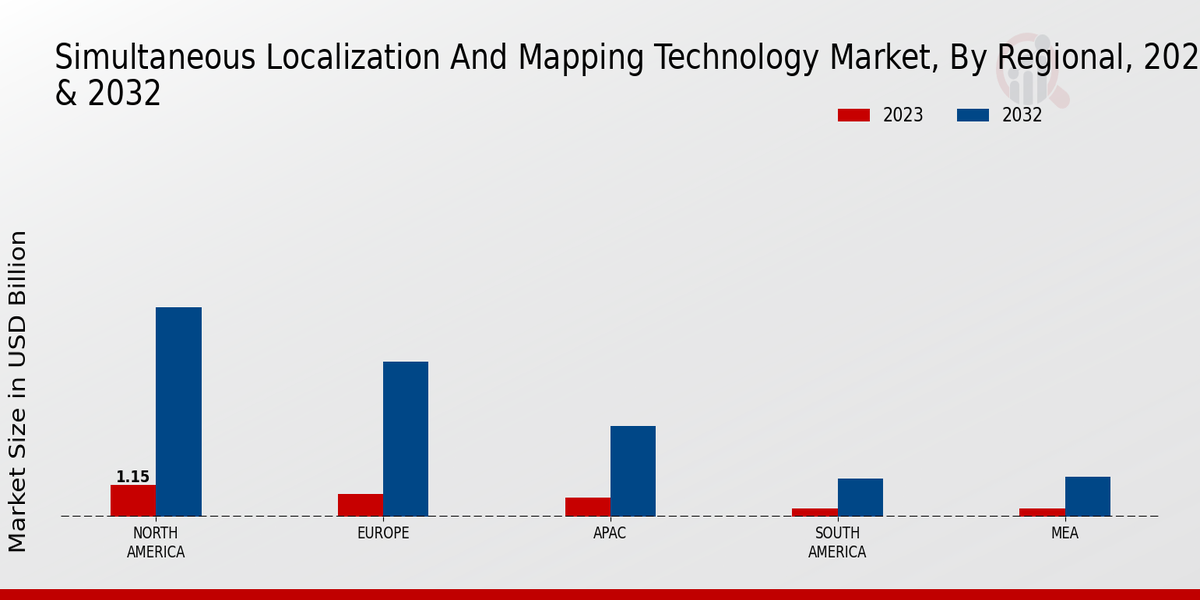Simultaneous Localization and Mapping Technology Market Overview
Simultaneous Localization Mapping Technology Market is projected to grow from USD 5.95 Billion in 2025 to USD 35.44 Billion by 2034, exhibiting a compound annual growth rate (CAGR) of 21.76% during the forecast period (2025 - 2034). Additionally, the market size for Simultaneous Localization Mapping Technology Market was valued at USD 4.89 billion in 2024.
Key Simultaneous Localization and Mapping Technology Market Trends Highlighted
The Global Simultaneous Localization and Mapping (SLAM) Technology Market is currently experiencing significant growth due to several key market drivers. The increasing demand for autonomous vehicles is a major factor, as these vehicles rely heavily on accurate mapping and localization capabilities for navigation and safety. Additionally, advancements in sensor technology and artificial intelligence are enhancing the performance of SLAM systems, enabling more precise and efficient operations across various applications.
Furthermore, the rise in smart devices and the Internet of Things (IoT) is creating new opportunities for SLAM technology to be integrated into consumer products and industrial automation.There are numerous opportunities to be explored within the SLAM technology landscape. Industries such as healthcare, agriculture, and logistics are beginning to adopt SLAM solutions to streamline operations and improve performance. In healthcare, for instance, SLAM technology can aid in navigating complex hospital environments, subsequently enhancing patient care and operational efficiency.
In agriculture, autonomous drones equipped with SLAM can assist in monitoring crop health and optimizing resource allocation. As more sectors recognize the potential benefits of SLAM, the demand for innovative solutions is expected to rise. In recent times, trends like the shift toward mobile and handheld devices have transformed SLAM applications.Researchers are increasingly focusing on developing lightweight and compact SLAM systems that can be easily integrated into consumer electronics.
Furthermore, there is a growing emphasis on cost-effective SLAM solutions that do not compromise on performance. Overall, these trends indicate a bright future for SLAM technology, opening doors to new applications and enhancing its relevance in an evolving technological landscape. As the market continues to evolve, staying attuned to these developments will be crucial for stakeholders aiming to capitalize on the growing opportunities presented by SLAM technology.
Figure 1: Simultaneous Localization and Mapping Technology Market Size, 2025-2034 (USD Billion)

Source: Primary Research, Secondary Research, MRFR Database and Analyst Review
Simultaneous Localization and Mapping Technology Market Drivers
Rising Demand for Autonomous Vehicles
The increasing demand for autonomous vehicles is one of the most significant drivers for the Simultaneous Localization and Mapping Technology Market Industry. As the automotive sector shifts toward automation, the need for advanced localization and mapping technologies becomes critical. Autonomous vehicles rely on precise and real-time data to navigate safely and efficiently through a variety of environments.
The technologies encompassed in the Simultaneous Localization and Mapping (SLAM) process enable vehicles to construct or update maps of their surroundings while simultaneously keeping track of their location.This dual operation is essential for ensuring the safety of passengers and pedestrians alike. As governments worldwide push for regulations and frameworks supporting self-driving technologies, the integration of SLAM systems into automotive designs will likely skyrocket.
Additionally, the development of infrastructure that supports autonomous vehicle operation, such as smart traffic signals and vehicle-to-everything (V2X) communication, will further propel the adoption of SLAM.Thus, as the automotive world moves towards a future dominated by autonomous capabilities, the global demand for Simultaneous Localization and Mapping Technology will continue to expand, significantly affecting market growth.
Industry players are expected to invest heavily in research and development to create better algorithms for mapping and localization. The competition will likely result in more innovative solutions, making adaptive SLAM technologies accessible for different applications beyond traditional automotive purposes, like delivery drones, urban planning, and even gaming applications.
Technological Advancements and Innovation
Rapid technological advancements and ongoing innovation are propelling the Simultaneous Localization and Mapping Technology Market Industry forward. The development of more sophisticated algorithms has enhanced the efficiency and accuracy of SLAM technology. Modern applications demand high levels of precision, and these advancements enable devices and systems to operate effectively in diverse environments. The integration of artificial intelligence (AI) and machine learning with SLAM technology permits smarter decision-making capabilities while optimizing data processing speeds.Consequently, the expanding range of applications and increasing consumer expectations are prompting manufacturers and developers to focus on innovation, thereby accelerating market growth.
Growing Adoption in Robotics
The rising adoption of robotics in various sectors is a significant driver for the Simultaneous Localization and Mapping Technology Market Industry. Robotics is increasingly utilized in industries like manufacturing, logistics, and healthcare, requiring precise navigation and mapping capabilities. SLAM technology allows robots to understand their surroundings, making them more efficient in tasks such as warehouse management and surgical procedures.As industries recognize the benefits of integrating robotics with SLAM systems, the demand for effective localization and mapping solutions is expected to surge.
Simultaneous Localization and Mapping Technology Market Segment Insights
Simultaneous Localization and Mapping Technology Market Application Insights
The Simultaneous Localization and Mapping Technology Market, with a projected revenue of 3.3 USD Billion in 2023, is experiencing robust growth across various application areas, showcasing its significance in modern technology. This market is expanding with an anticipated increase to 19.4 USD Billion by 2032, demonstrating the increasing reliance on localization and mapping technologies in different sectors.
Robotics holds a significant position in this landscape, valued at 0.9 USD Billion in 2023 and expected to rise to 5.5 USD Billion by 2032, indicating its crucial role in automating processes and enhancing operational efficiency in sectors like manufacturing and logistics.The Automotive segment is also pivotal, starting from a valuation of 1.2 USD Billion in 2023 and projected to reach 7.0 USD Billion by 2032. This growth emphasizes the importance of localization technologies in advanced driver-assistance systems and autonomous vehicles, which require accurate mapping to navigate effectively.
Drones are valued at 0.8 USD Billion in 2023 and are expected to escalate to 4.5 USD Billion by 2032, reflecting their increasing utilization in various applications such as surveying, agriculture, and delivery services. Moreover, Augmented Reality has a valuation of 0.4 USD Billion in 2023, with a predicted rise to 1.9 USD Billion by 2032, signifying the growing demand for immersive experiences in retail, training, and entertainment.
Virtual Reality, while currently valued at 0.0 USD Billion in 2023, is anticipated to grow to 0.5 USD Billion by 2032, highlighting its emerging use in gaming and educational applications. Collectively, the Simultaneous Localization and Mapping Technology Market segmentation offers valuable insights into the dynamics of technology adoption across industries, revealing the immense opportunities that lie ahead in enhancing navigation capabilities and the overall user experience through advancements in localization and mapping technologies.

Source: Primary Research, Secondary Research, MRFR Database and Analyst Review
Simultaneous Localization and Mapping Technology Market Technology Insights
The Simultaneous Localization and Mapping Technology Market is poised for significant growth, with a market value of 3.3 USD billion in 2023 and projected to reach 19.4 USD billion by 2032. The market exhibits a robust CAGR of 21.76 from 2024 to 2032, driven by increasing adoption across various industries, including robotics, automotive, and augmented reality. Within this market, the segments of 2D Mapping and 3D Mapping play crucial roles, as they cater to diverse applications requiring precise spatial awareness and navigation capabilities.
Visual SLAM is gaining traction due to its effectiveness in environments where GPS signals are unreliable, making it vital for applications such as autonomous vehicles and drones. LiDAR SLAM, with its ability to provide accurate, high-resolution mapping, is significant in urban planning and construction. Graph-Based SLAM is increasingly utilized for efficient optimization in mapping processes. Overall, the Simultaneous Localization and Mapping Technology Market segmentation reflects the growing trend toward advanced navigation solutions, underscoring the need for effective mapping technologies in a range of applications.
Simultaneous Localization and Mapping Technology Market End Use Insights
The Simultaneous Localization and Mapping Technology Market is expected to be valued at 3.3 billion USD in 2023 and is experiencing a steady increase in market growth across various end-use segments. These segments include Consumer Electronics, Military and Defense, Healthcare, Transportation, and Logistics.
The Consumer Electronics domain significantly leverages this technology for enhancing user experience through improved navigation and augmented reality applications. Meanwhile, the Military and Defense sector adopts these systems for strategic operations and real-time mapping, making it a crucial area for technological advancement.In Healthcare, Simultaneous Localization and Mapping technology plays an important role in hospital navigation and tracking medical equipment, thus streamlining operations and improving patient care.
Transportation and Logistics sectors utilize this technology for optimizing route management and inventory tracking, which is vital for enhancing efficiency and reducing costs. The diverse applications across these end-use sectors underline the significance and growing relevance of the Simultaneous Localization and Mapping Technology Market, thereby showcasing a robust market data trajectory that supports ongoing innovation and market expansion.
Simultaneous Localization and Mapping Technology Market Component Insights
The Simultaneous Localization and Mapping Technology Market, valued at 3.3 USD billion in 2023, showcases a diverse array of components, each contributing significantly to its growth trajectory. Among these, software plays a crucial role, providing the essential algorithms and frameworks needed for efficient data processing and spatial analysis. Sensors are another key component, as they enable real-time data collection and environmental mapping, which is indispensable in various applications like autonomous vehicles and robotics.
Cameras, often combined with sensors, are critical for visual recognition and depth perception, helping systems to navigate and understand surroundings accurately.Processing units, which handle the heavy computational tasks, support real-time localization and mapping, enhancing overall system performance. The category of 'Others' includes various auxiliary components that contribute to the robustness and flexibility of the technology, ensuring it meets the demands of different industries.
The market's growth is driven by increasing automation and advancements in AI, while challenges such as technological integration and cost management present opportunities for innovative solutions. The overall market data reflects a promising trend where the integration of these components is set to foster significant advancements in the Simultaneous Localization and Mapping Technology Market industry.
Simultaneous Localization and Mapping Technology Market Regional Insights
The Simultaneous Localization and Mapping Technology Market revenue showcases a robust growth trajectory across various regions, with North America leading in valuation. In 2023, North America was valued at 1.151 USD Billion, and it is expected to reach 7.618 USD Billion by 2032, reflecting its majority holding due to advanced technology adoption and significant investment in research. Europe follows, valued at 0.844 USD Billion in 2023 and projected to rise to 5.627 USD Billion, driven by increasing demand for automation and robotics in various industries.
The APAC region, valued at 0.691 USD Billion in 2023, is anticipated to grow to 3.289 USD Billion, benefiting from rapid urbanization and technological advancements in countries like China and India. Meanwhile, South America and the MEA region, both valued at 0.307 USD Billion in 2023, exhibit potential growth opportunities in emerging markets, with projected values of 1.385 USD Billion and 1.472 USD Billion respectively by 2032. The varied market growth across these regions highlights the significance of local technological development, investment capacities, and market readiness, giving insights into the diverse opportunities and challenges in the Simultaneous Localization and Mapping Technology Market industry.

Source: Primary Research, Secondary Research, MRFR Database and Analyst Review
Simultaneous Localization and Mapping Technology Market Key Players and Competitive Insights
The Simultaneous Localization and Mapping Technology Market has witnessed a significant surge in interest and innovation driven by the growing demand for navigation systems in various industries. The competitive landscape reflects a dynamic environment where established players and emerging startups are striving to enhance their technology offerings.
The extensive applications of SLAM technology in autonomous vehicles, robotics, augmented reality, and other sectors have intensified competition among market participants. Companies in this sector are focusing on research and development to improve accuracy, efficiency, and user experience, highlighting the key trends that shape this market. The integration of artificial intelligence and machine learning into SLAM systems is set to propel advancements, creating an arena where companies must continuously innovate to maintain their competitive edge.
Furthermore, strategic partnerships, mergers, and acquisitions are common as firms seek to leverage new technologies and expand their market reach, which adds to the overall competitiveness within this landscape.Microsoft has established a formidable presence in the Simultaneous Localization and Mapping Technology Market, leveraging its extensive expertise in cloud computing and artificial intelligence. The company's robust technological infrastructure supports its efforts to develop advanced SLAM solutions, enabling applications in various domains such as robotics and augmented reality.
Microsoft's commitment to research and development empowers it to deliver high-quality, scalable solutions that resonate well with customers needing reliability and precision in their localization and mapping technologies. Additionally, Microsoft’s strong ecosystem, coupled with its partnerships, allows for seamless integration of SLAM technology into broader software platforms, creating opportunities for enhanced functionalities and user experiences.
This establishes Microsoft as a key player in the market, illustrating its strengths in technology innovation and customer engagement.Sony, on the other hand, holds a significant role in the Simultaneous Localization and Mapping Technology Market with its innovative products and growing applications in consumer electronics and multimedia systems. The company's advancements in camera technology and sensor integration have positioned it well to capitalize on the SLAM technology trend, particularly within the realms of augmented reality and virtual reality.
Sony’s focus on creating immersive experiences aligns seamlessly with the capabilities offered by SLAM systems, allowing for enhanced user interactions across its product lines. Furthermore, the company’s reputation for high-quality imaging technologies strengthens its ability to develop sophisticated localization solutions that can be utilized in a wide range of applications. Through continuous innovation and strategic initiatives, Sony is making strides within the SLAM technology ecosystem, highlighting its potential in shaping the future of navigation and mapping technologies.
Key Companies in the Simultaneous Localization and Mapping Technology Market Include:
Simultaneous Localization and Mapping Technology Market Industry Developments
Recent developments in the Global Simultaneous Localization and Mapping (SLAM) Technology Market reveal significant strides made by major players. Microsoft has been enhancing its Azure Mixed Reality services to improve spatial mapping, while Google is advancing its Indoor Maps and AR capabilities, asserting its presence in the market. Qualcomm is focusing on developing advanced processors that facilitate efficient SLAM algorithms, aiding in robotics and autonomous vehicle navigation.
HERE Technologies has been partnering with automotive manufacturers to integrate mapping technologies in the latest vehicle models. Notably, Apple has been investing heavily in spatial awareness technology as part of its strategy for augmented reality applications. On the acquisition front, Trimble recently acquired a small software firm specializing in 3D mapping, which will bolster its capabilities in surveying and construction, confirming the trend of consolidation in this space.
Additionally, companies like Nvidia and Intel are making significant investments in AI and deep learning to enhance SLAM technologies, which is anticipated to drive market growth. The increasing demand for autonomous vehicles and robotics is also expected to impact market valuations positively, reflecting a broader trend towards automation in various sectors.
Simultaneous Localization and Mapping Technology Market Segmentation Insights
-
Simultaneous Localization and Mapping Technology Market Application Outlook
-
Simultaneous Localization and Mapping Technology Market Technology Outlook
-
Simultaneous Localization and Mapping Technology Market End Use Outlook
-
Simultaneous Localization and Mapping Technology Market Component Outlook
-
Simultaneous Localization and Mapping Technology Market Regional Outlook
| Report Attribute/Metric |
Details |
|
Market Size 2024
|
4.89 (USD Billion)
|
|
Market Size 2025
|
5.95 (USD Billion)
|
|
Market Size 2034
|
35.44 (USD Billion)
|
|
Compound Annual Growth Rate (CAGR)
|
21.76% (2025 - 2034)
|
|
Report Coverage
|
Revenue Forecast, Competitive Landscape, Growth Factors, and Trends
|
|
Base Year
|
2024
|
|
Market Forecast Period
|
2025 - 2034
|
|
Historical Data
|
2019 - 2023
|
|
Market Forecast Units
|
USD Billion
|
| Key Companies Profiled |
Microsoft, Sony, Qualcomm, HERE Technologies, Trimble, IBM, Apple, Google, TomTom, NavVis, Intel, Facebook, SLAMcore, Nvidia, Amazon |
| Segments Covered |
Application, Technology, End Use, Component, Regional |
| Key Market Opportunities |
Autonomous vehicle navigation systems, Robotics and automation integration, Enhanced AR/VR experiences, Smart city development initiatives, Defense and military applications. |
| Key Market Dynamics |
Increased automation demand, Advancements in AI technology, Growing robotics applications, Rising demand for AR/VR, Expanding autonomous vehicle sector |
| Countries Covered |
North America, Europe, APAC, South America, MEA |
Frequently Asked Questions (FAQ) :
By 2034, the Simultaneous Localization and Mapping Technology Market is expected to be valued at 35.44 USD Billion.
The CAGR for the Simultaneous Localization and Mapping Technology Market is anticipated to be 21.76% from 2025 to 2034.
North America is expected to dominate the Simultaneous Localization and Mapping Technology Market with a projected value of 7.618 USD Billion by 2032.
The Robotics application segment is expected to reach a market value of 5.5 USD Billion by 2032.
The Automotive application segment is projected to grow significantly to 7.0 USD Billion by 2032.
The Drones application segment is expected to be valued at 4.5 USD Billion by 2032.
Key players in the market include Microsoft, Sony, Qualcomm, HERE Technologies, and Trimble among others.
The Augmented Reality application segment is projected to reach a market size of 1.9 USD Billion by 2032.
By 2032, the Europe region is expected to have a market size of 5.627 USD Billion.
Challenges such as technology integration and competition from alternative localization technologies may impact market growth.

















